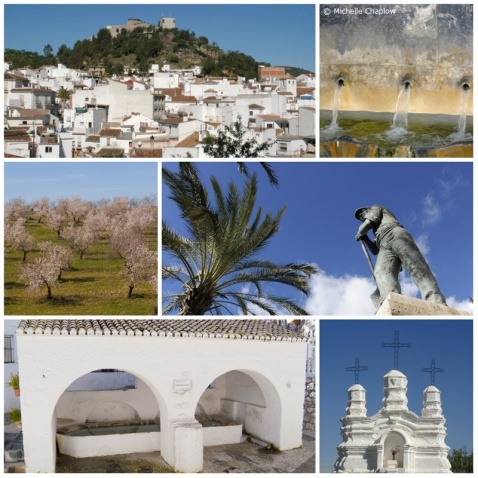
The village of Monda, the village fountain, almond groves, the statue, The old public washing facility, Fuente de la Jaula and the altarpiece of el Calvario. ( Click to enlarge images) © Michelle Chaplow |
|
Monda - THINGS TO SEE
Monda has a small central village square, Plaza de la Ermita, with the Monument to the Miner and some interesting bars. Just outside the square, on Calle de la Jaula (the A-7010 road to Guaro) is the preserved municipal lavadero and the popular Bar de la Luna and Bodega de la Plazolete.
Fuente Lavadero de la Jaula is the town fountain and roofed lavadero (public laundry area), once a focus for social exchange, which dates from the 16th century.
Casa Museo Marigloria
This rural museum is in a typical village house, decorated in the style of the early 20th century (c/ Amargura 2, near Plaza de Andalucia). On display are tools, household objects and stoves that were used by the labourer. The owner of the house turned it into a museum and happily for us, remains open to this day; there is no admission fee to visit.
Iglesia de Santiago Apostol
This parish church was built rapidly following the reconquest in 1505 - within a century it was in need of complete restoration. This task fell to Diaz Palacio, archbishop of Sevilla, and work commenced in 1605. Two extra chapels were added in the 18th century, but the original plan remains.
The main facade comprises of a large half-round arch supported on two pilasters above which lies the upper floor, presided over by an image of Santiago. Inside there are three naves, separated by rectangular columns and half-round arches. The central aisle (epistle nave) has an intricately-decorated vaulted roof, while the side naves have normal roves. The presbytery is covered by a hemispherical vault and the adjoining chapels are decorated with 18th-century plasterwork. The four-tiered tower has half-round arches on the belfry tier.
Diaz Palacio's stone crest is high above the main door. Below it, in a circular opening, you can see a detailed ceramic image of Santiago Matamoros, sword in hand, riding a white horse, made from 69 small tiles. This ceramic was a donation by Doctor Cristobal Jimenez Encina in the mid-1940s. The eminent doctor, native of Monda and hijo predilicto (nominated son) of the village, has a street named after him and a bust in Plaza Andalucia.
Numerous fountains
Fuente de la Villa, Fuente de La Esquena, Fuente de la Mea-Mea, La Jaura, Los Morales.
Mirador on Calle Consejo
This viewing point overlooking the town, on the Marbella road, has a balcony that hangs over the village - not for those with vertigo. The mirador has a single column support rather than a cantilever.
Monumento del Calvario
This 18th-century religious monument, an open-air shrine and altarpiece, is located on the edge of the village (end of Calle Calvario, off Calle Malaga). It is the last of the stations of the cross which you see on ceramic plaques throughout the village, celebrated in Semana Santa. Erected in the 1770s on the instruction of Juan de Cozar Gallo y Torrecilla, the white triple-towered monument is made of plastered and whitewashed brick, and measures three metres high.
Each of the three towers supports a small wrought-iron cross; in the centre is a niche that may once have contained a religious statue. The area in front of the shrine has been paved with stones set in a circular pattern once used for threshing wheat. Today the threshing no longer takes place, however the whitewashing continues.
Castillo de Monda
The Castillo de Monda has enjoyed mixed fortunes over the centuries. Read about its history and the love story of Arturo, Beatriz and the blood-red almond blossom. More>
Roman road.
Just outside the village, after Calle Malaga on a sharp bend of the A-7101, a sign indicates 100m down a track past some houses. Fork right and you will soon reach the old cobbled surface of the Roman road from Monda to Cartama. A 100m stretch can be seen as it descends steeply to the Arroyo Casarín. The sign and other literature also refers to a (mythical) 'Puente del Arroyo de la Teja'.
Mudejar Olive oil mill
Just outside the village after Calle Malaga is the Mudejar olive oil mill, built relatively recently but nevertheless worth a visit. The production takes place in December and January and you can watch the process. Outside are the hoppers where the olives are separated from the stray branches and leaves. Inside are the centrifuge machines for decanting and the bottling plant. In the factory shop you can buy glass presentation bottles of cold-pressed AOVE (extra virgin olive oil) in 25cl, 50cl or 75cl sizes for less than 5€. Open 09.00 - 14.00 hrs and 15.30 to 19.00 Tuesdays, Thursdays, Fridays and Saturdays.
Marbella Design Academy
The town is home to the Marbella Design Academy.